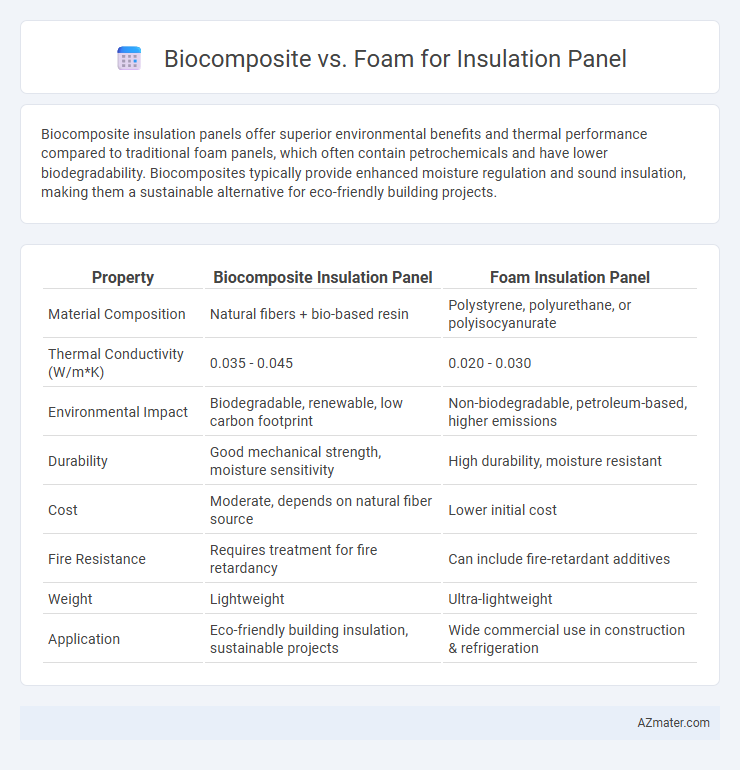Biocomposite insulation panels offer superior environmental benefits and thermal performance compared to traditional foam panels, which often contain petrochemicals and have lower biodegradability. Biocomposites typically provide enhanced moisture regulation and sound insulation, making them a sustainable alternative for eco-friendly building projects.
Table of Comparison
| Property | Biocomposite Insulation Panel | Foam Insulation Panel |
|---|---|---|
| Material Composition | Natural fibers + bio-based resin | Polystyrene, polyurethane, or polyisocyanurate |
| Thermal Conductivity (W/m*K) | 0.035 - 0.045 | 0.020 - 0.030 |
| Environmental Impact | Biodegradable, renewable, low carbon footprint | Non-biodegradable, petroleum-based, higher emissions |
| Durability | Good mechanical strength, moisture sensitivity | High durability, moisture resistant |
| Cost | Moderate, depends on natural fiber source | Lower initial cost |
| Fire Resistance | Requires treatment for fire retardancy | Can include fire-retardant additives |
| Weight | Lightweight | Ultra-lightweight |
| Application | Eco-friendly building insulation, sustainable projects | Wide commercial use in construction & refrigeration |
Introduction to Insulation Panel Materials
Insulation panels are essential components in modern construction, providing thermal resistance and energy efficiency. Biocomposite materials, derived from natural fibers and biodegradable polymers, offer sustainable alternatives that combine eco-friendliness with good insulating properties. Foam insulation panels, made from synthetic polymers like polyurethane or polystyrene, deliver high thermal performance and moisture resistance but may pose environmental concerns due to their manufacturing and disposal processes.
What Are Biocomposites?
Biocomposites are materials composed of a polymer matrix reinforced with natural fibers such as hemp, flax, or jute, offering sustainable alternatives to conventional insulation panels. These eco-friendly composites provide excellent thermal insulation, enhanced mechanical strength, and reduced environmental impact compared to traditional foam panels. The growing demand for sustainable building materials drives innovation in biocomposite insulation, combining biodegradability with effective energy efficiency.
Understanding Foam Insulation Panels
Foam insulation panels, commonly made from polyurethane or polystyrene, offer superior thermal resistance with R-values typically ranging from 3.6 to 8 per inch, making them highly effective for energy-efficient building envelopes. Their closed-cell structure provides excellent moisture resistance and durability, minimizing the risk of mold and structural damage. Compared to biocomposite panels, foam insulation delivers consistent performance and ease of installation, ideal for applications requiring reliable, long-term thermal barrier solutions.
Thermal Performance: Biocomposite vs Foam
Biocomposite insulation panels exhibit superior breathability and moisture regulation compared to foam, enhancing thermal comfort and reducing condensation risks. Foam insulation panels, such as polyurethane or polystyrene, offer higher R-values per inch, resulting in greater resistance to heat transfer and improved energy efficiency. The choice between biocomposite and foam insulation depends on balancing thermal performance with environmental impact and indoor air quality considerations.
Environmental Impact and Sustainability
Biocomposite insulation panels use natural fibers like hemp, flax, or wood, resulting in lower carbon footprints and enhanced biodegradability compared to conventional foam panels made from petroleum-based materials. Foam insulation often contains harmful blowing agents and is less recyclable, contributing to long-term environmental pollution. The sustainable sourcing and end-of-life compostability of biocomposites significantly reduce ecological impact and promote circular economy principles in building materials.
Fire Safety and Resistance Comparison
Biocomposite insulation panels offer enhanced fire resistance due to their natural fiber content combined with fire-retardant additives, resulting in slower flame spread and reduced smoke emission compared to traditional foam panels. Foam insulation, especially polyurethane and polystyrene types, often pose higher flammability risks and release toxic gases during combustion, necessitating additional fire retardants to meet safety standards. Regulatory compliance like ASTM E84 and Euroclass ratings often favor biocomposite materials for superior fire performance, making them a safer choice for fire-prone environments.
Moisture Resistance and Durability
Biocomposite insulation panels typically offer superior moisture resistance compared to traditional foam panels due to their natural fiber composition and breathability, which reduces mold risk and moisture buildup. Foam insulation panels, such as expanded polystyrene (EPS) or polyurethane, provide strong water resistance but can trap moisture, potentially leading to degradation over time if not properly sealed. In terms of durability, foam panels generally exhibit higher structural integrity and longer lifespan under harsh conditions, while biocomposites may require protective treatments to enhance longevity and resist biological deterioration.
Cost Analysis: Biocomposite vs Foam
Biocomposite insulation panels typically present higher upfront costs compared to traditional foam panels due to raw material expenses and production complexity, yet offer long-term savings from enhanced durability and eco-friendly benefits. Foam panels, such as polyurethane or polystyrene, are generally more cost-effective initially with lower material costs and widespread availability but may incur higher environmental and disposal costs over time. Life cycle cost analysis reveals biocomposites can provide better value through reduced maintenance and improved sustainability metrics, making them a competitive alternative in green building applications.
Applications and Use Cases
Biocomposite insulation panels excel in sustainable building applications due to their eco-friendly materials and superior moisture resistance, making them ideal for residential and commercial walls and roofing. Foam insulation panels, such as polyurethane or polystyrene, offer high thermal resistance and are commonly used in industrial settings, cold storage, and underfloor insulation for energy efficiency. Both materials support sustainable construction, but biocomposites are preferred for green certification projects while foam panels deliver cost-effective, high-performance insulation in diverse climates.
Future Trends in Insulation Panel Materials
Biocomposite insulation panels are gaining traction due to their eco-friendly attributes, enhanced thermal performance, and biodegradability, positioning them as a sustainable alternative to traditional foam materials like EPS and polyurethane. Innovations in nanocellulose additives and bio-based resin formulations are driving improvements in fire resistance, moisture control, and structural integrity for biocomposite panels. Future trends emphasize circular economy principles, increased use of agricultural waste, and hybrid composites that combine the lightweight properties of foam with the environmental benefits of biocomposites for next-generation insulation solutions.

Infographic: Biocomposite vs Foam for Insulation Panel
 azmater.com
azmater.com